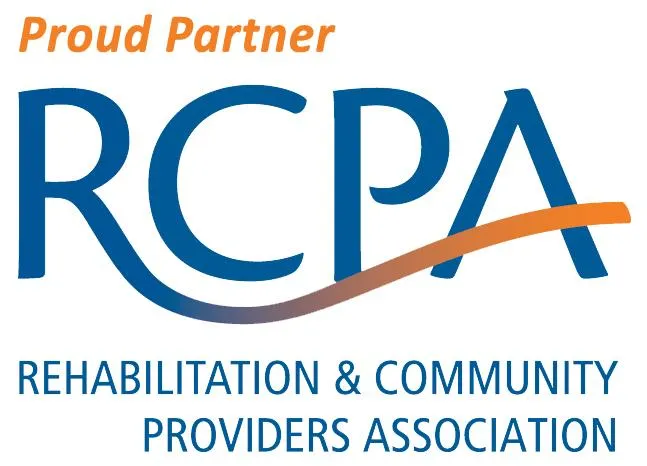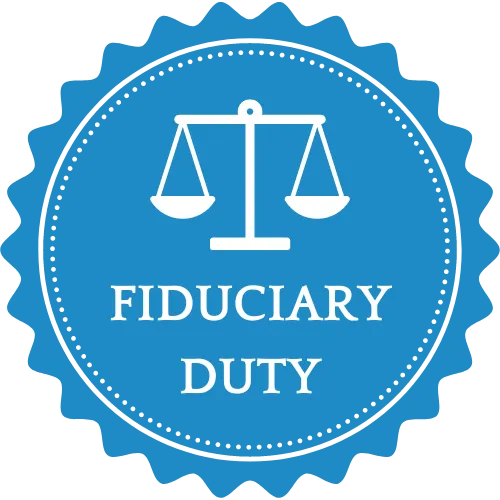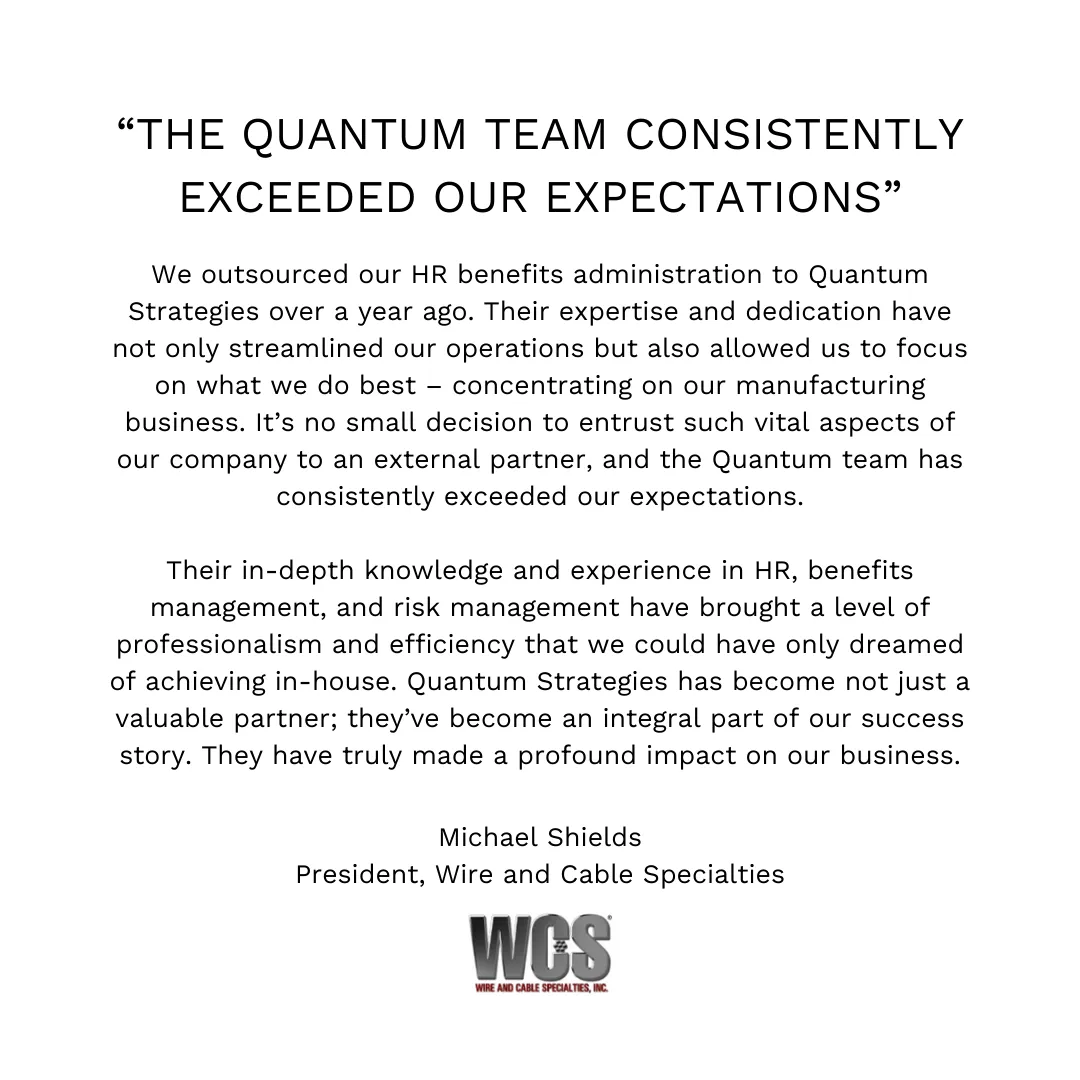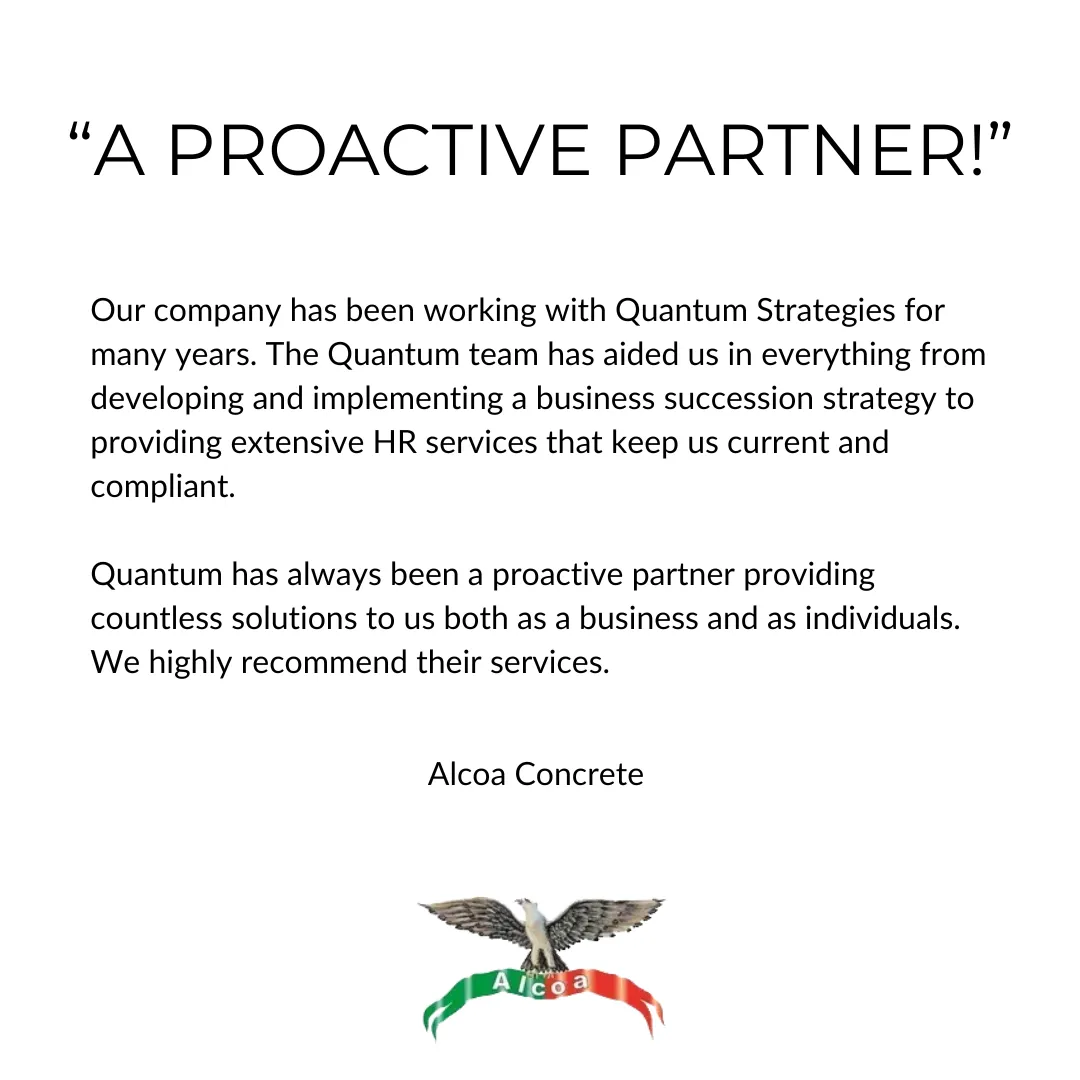Tailored HR Solutions as Unique as Your Business
Expert consulting and service to elevate your HR from a headache to a value driver.
Does Your HR Function Make the Grade?
Take our 5-minute quiz and evaluate the effectiveness of your HR function.

How We Help
We Focus on Your HR Needs,
So You Can Focus on Your Mission.
At Quantum Strategies, we understand that effective human resource management is the cornerstone of every successful business, regardless of size. Our mission is to provide tailored HR solutions that align perfectly with your unique business needs and growth stage.
Our Services
Navigating Change with Confidence: Quantum Expert HR Solutions
From Policy Assistance to Leadership Succession Planning, Quantum Strategies is Your Ultimate HR Resource to Solve Your Business Challenges.
HR Operational
Assessments
Unlock the full potential of your HR department. Our collaborative approach brings clarity and efficiency to your HR operations, providing a thorough analysis of your department's structure, costs, effectiveness, and needs.
Comprehensive Analysis: Detailed evaluation of your organization, workgroups, and individual roles for optimized efficiency.
Objective Insights: Receive a clear blueprint highlighting your HR department's strengths, weaknesses, and gaps.
Strategic Recommendations: Actionable plans focusing on technology utilization, communication enhancement, and leveraging department strengths.
HR Consulting and Managed Services
Tailored to align with your unique needs, our HR consulting and managed services enhance operational efficiency and effectiveness, allowing you to focus on your core mission while we optimize your HR investment.
Expert Supplemental Support: Strengthen your existing HR team with specialized expertise to navigate complex HR landscapes.
Personalized, Agile Solutions: Customized services for organizations with or without HR teams, adaptable to your specific requirements.
Goal-Oriented, Clear Communication: Delivering precise, actionable strategies that align with your organization’s goals and ensure successful execution.
Custom HRIS Design and Integration
Revolutionize your HR data management. Our team will evaluate your current human resources technology stack, offer recommendations, and then integrate your new and existing systems with our cutting-edge technology, ensuring seamless data flow and optimized operational efficiency.
Seamless Integration: Connect legacy systems with modern platforms for streamlined data management.
Tailored Design: Custom HRIS solutions uniquely crafted to meet your specific business needs.
Advanced Analytics: Leverage data-driven insights for strategic decision-making and operational excellence.
“Successfully steering through the specialized HR challenges within organizations of all kinds demands expert understanding, strategic planning, and precise implementation. With comprehensive knowledge of these challenges and the right solutions, your business can stay focused and successful in their vital missions.”
William J. Rizzo

Who we Are.
We Focus on Your HR Needs,
So You Can Focus on Your Mission.
At Quantum Strategies, we recognize that proficient management of human resources is fundamental to the success of any enterprise, irrespective of its scale. Our objective is to deliver customized human resource solutions that are in perfect harmony with your distinct business requirements and developmental phase.
Constant Improvement
Commitment to Customers
High Level Of Knowledge
Best Service You Can Get



Why Choose Us
A True Partner to Solve Your Most Complex HR Challenges.
Empowering HR Innovation and Compliance
Commitment to 100% Client Satisfaction
People-First Approach

Peace of Mind:
Handle ongoing compliance with ease

Employee Satisfaction:
Build a positive workplace with engaged employees

Strategic Confidence:
Drive strategy with advanced analytics

Leadership Development:
Equip your team with the tools to lead

2,245 +
Happy Clients

25 +
Years Of Experience

120 +
Professional Team
Testimonials
The Quantum Commitment - 100% CLIENT SATISFACTION!
At Quantum, we understand that your satisfaction matters most, and The Quantum Commitment is our way of putting that understanding into action. Experience the difference with a team that is dedicated to making your satisfaction the cornerstone of our service. Because when you choose Quantum, you choose excellence, reliability, and a commitment to exceeding your expectations every time.
Our Resources
Unveiling Proven Strategies and Insights.
Discover actionable tips, expert advice, and industry insights to fuel your journey towards success.

Fostering a Psychologically Safe Workspace
As we navigate the complexities of the post-pandemic world, the importance of mental health in the workplace has surged to unprecedented levels. According to research from the
American Psychological Association, 81% of employees are now actively seeking workplaces prioritizing mental well-being.
Key Challenges Faced by Human Resources in Nonprofit Organizations
The nonprofit sector brings its own set of specialized difficulties, especially in the area of human resources (HR). Although these difficulties may share some common ground with those in the for-profit industry, they possess unique characteristics that require special attention from nonprofit leaders.
FOUND THESE HELPFUL?
Explore Additional Articles and Resources In Our Blog

The End of Annual Reviews: Why Continuous Feedback is the Future of Performance Management
The End of Annual Reviews: Why Continuous Feedback is the Future of Performance Management
Why It's Time to Move Beyond Annual Performance Reviews
The Problem with Annual Performance Reviews
The Decline of the Annual Performance Review
The Rise of Continuous Performance Check-Ins
2. Increased Employee Engagement
3. Goal Alignment and Tracking
4. Stronger Manager-Employee Relationships
5. More Personalized Development Plans
7. More Accurate Performance Assessments
How Digital-First Check-Ins Can Transform Performance Management
Implementing Continuous Performance Reviews in Your Organization
1. Educating Managers and Employees
3. Establish a Consistent Check-In Schedule
4. Encourage Self-Assessments and Peer Feedback
5. Create Actionable Development Plans
Key Takeaways

Why It's Time to Move Beyond Annual Performance Reviews
Performance evaluations have long been seen as a cornerstone of employee development within organizations. These reviews — including the traditional annual performance discussions — have historically provided opportunities for managers to give feedback, set clear goals, and identify areas where employees can improve. However, as the workplace and the way we work continue to evolve, it has become clear that the traditional annual performance review system is outdated and ineffective in today’s fast-paced, dynamic environment. According to research from McKinsey, organizations that prioritize people-centric performance management are 4.2 times more likely to outperform their peers, delivering better growth, lower attrition, and stronger organizational health.
Annual reviews, once considered the gold standard of performance management, are increasingly being replaced by a more modern and effective approach: continuous feedback. This shift is driven by the growing recognition that a year-long gap between performance evaluations is simply too long for meaningful growth and improvement to occur. With the rapid pace of the change in business priorities, technology, and job roles, waiting for annual feedback can leave employees without the guidance and insight they need to perform at their best.
As more companies embrace this shift, regular, ongoing check-ins between managers and employees have become the preferred method for assessing performance, setting goals, and identifying areas of development. This transition to continuous feedback is more than just a trend—it represents a fundamental change in the way organizations view employee development, engagement, and overall performance management.
The Problem with Annual Performance Reviews
One of the most significant issues with annual performance reviews is the timing. When employees receive feedback only once a year, it is often outdated and no longer helpful. Employees may have already moved past the issues being discussed, or worse, they may have continued ineffective behavior for months before receiving any guidance.
Additionally, annual reviews are costly and time-consuming. Studies estimate that companies with 10,000 employees spend around $35 million annually on performance reviews. Despite this investment, many employees and managers dread the process because it feels like a formality rather than a meaningful tool for improvement.
Another issue is that annual reviews tend to focus too much on past performance rather than future growth. Employees are evaluated on what they did over the past year, but there is little discussion on how to develop their skills moving forward. This backward-looking approach can lead to stagnation rather than continuous improvement.
Traditional performance reviews can create unnecessary stress as they are often tied to bonuses and raises. Employees often feel anxious about receiving a performance rating. At the same time, managers struggle to balance fairness with the need for constructive criticism and a balanced budget. Managers often must align ratings to their budget rather than ratings based solely on performance. This pressure can diminish the effectiveness of the review process and discourage open communication.
The Decline of the Annual Performance Review
Annual reviews used to be the standard, an annual opportunity to provide constructive feedback and give raises. But today, employees and managers alike find them ineffective.
55% of workers say their annual reviews do not improve their performance.
Only 13% of employees and managers find them useful.
Between 2016 and 2019, the number of companies using annual reviews dropped from 82% to 54%.
The shift away from annual performance reviews became even more pronounced during the COVID-19 pandemic. Many companies reevaluated their performance review strategies and moved toward more frequent check-ins to adapt to remote work. This transition reduced stress and created a culture of continuous feedback. As businesses settle into new ways of working, continuous performance management is becoming the preferred model.
The Rise of Continuous Performance Check-Ins
In recent years, companies have begun moving away from traditional yearly performance reviews in favor of a continuous feedback model. This shift reflects a growing recognition that performance management is not something that should be assessed only once a year, but rather something that requires ongoing attention and adjustment throughout the year. By implementing regular check-ins—whether they are weekly, monthly, or quarterly—organizations can foster more frequent and productive conversations between managers and employees. These regular interactions provide an opportunity for managers to offer real-time feedback.
Instead of waiting for a formal, end-of-year evaluation to discuss progress, a continuous feedback approach allows both managers and employees to maintain a clear and consistent understanding of performance expectations and development. These check-ins not only allow employees to receive timely guidance, but also offer a platform to discuss career aspirations, skill development, and potential growth opportunities. By having more frequent touchpoints, employees are better equipped to adjust their performance in real-time, rather than waiting months for feedback on their work. This also allows managers to be more proactive in their support, identifying strengths to reinforce and areas for improvement before they become larger issues.
Moreover, regular performance check-ins help build a culture of transparency and open communication, which are key drivers of employee engagement and satisfaction.
Here are some of the key benefits of continuous performance management:
1. Real-Time Feedback
Employees receive immediate feedback rather than waiting months for an assessment. This allows them to make timely improvements and fosters a culture of continuous learning.
2. Increased Employee Engagement
Frequent check-ins provide employees with a platform to voice concerns, discuss challenges, and seek guidance. This results in a more engaged and motivated workforce. 85% of employees who check in with their managers weekly report higher engagement levels.
3. Goal Alignment and Tracking
Ongoing performance discussions help employees stay aligned with organizational goals. Managers and employees can track progress and adjust objectives in real time.
4. Stronger Manager-Employee Relationships
Regular conversations build trust and create an open dialogue between managers and employees, making performance management a more positive experience.
5. More Personalized Development Plans
Continuous feedback allows managers to customize employee development plans based on their specific needs and career aspirations.
6. Reduced Employee Turnover
Employees receiving consistent feedback and recognition are more likely to stay with their organization, reducing recruitment and training costs. Companies using continuous feedback see a 24% improvement in employee performance.
7. More Accurate Performance Assessments
Frequent conversations provide a clearer picture of an employee's performance over time rather than relying on a single annual snapshot.

How Digital-First Check-Ins Can Transform Performance Management
Many companies are now leveraging technology to streamline continuous feedback. Digital-first check-ins allow organizations to automate the process, making it easier for managers and employees to stay connected. Key features of digital performance management systems include:
Centralized platforms to document feedback, goals, and development plans
Real-time updates that allow for instant feedback and goal adjustments
No ratings or rankings, focusing on qualitative conversations rather than a numerical score
AI-driven insights to help managers identify trends and provide data-driven feedback
Integrated learning tools to suggest training programs based on employee performance and goals
Automated reminders to ensure check-ins happen consistently without being forgotten
Data analytics dashboards that help managers track trends in employee performance
Implementing Continuous Performance Reviews in Your Organization
Transitioning from annual reviews to continuous performance check-ins requires thoughtful planning. Here are some best practices:
1. Educating Managers and Employees
Train leaders on the importance of ongoing feedback and equip them with the skills to have productive performance conversations.
2. Invest in the Right Tools
Use performance management software to facilitate real-time feedback, goal tracking, and automated check-ins. Our Maximum Accountability technology is a versatile tool for performance management and other HR functions.
3. Establish a Consistent Check-In Schedule
Decide on a frequency (weekly, biweekly, or monthly) and ensure that check-ins become a regular part of company culture.
4. Encourage Self-Assessments and Peer Feedback
Give employees the opportunity to assess their own progress and receive input from colleagues. Peer feedback can enhance collaboration and personal growth.
5. Create Actionable Development Plans
Each check-in should result in a clear, actionable development plan that includes skill-building opportunities, project assignments, or mentorship programs.
6. Make Feedback a Two-Way Process
Employees should also be encouraged to provide feedback to their managers. This can help create a culture of transparency and trust.
7. Track and Measure Progress
Use key performance indicators (KPIs) to evaluate the effectiveness of continuous check-ins and adjust the approach as needed.
The Future of Performance Management
Moving away from annual performance reviews towards continuous feedback is not just a trend—it's the future of performance management. Organizations that embrace this change will benefit from higher engagement, increased productivity, and better alignment with their business goals.
In the coming years, performance management will continue to evolve with the integration of artificial intelligence, advanced analytics, and employee-driven feedback loops. Companies that prioritize real-time performance, tracking, and development will have a competitive edge in attracting and retaining top talent.
Focusing on employee well-being and mental health will also play a more significant role in performance management. Companies will likely incorporate wellness check-ins alongside traditional performance discussions, ensuring employees feel supported in all aspects of their work life.
Now is the time to modernize your approach, are you ready to transform the company performance management? Contact us today to learn how implementing digital-first check-ins can revolutionize your workforce, increase engagement, and drive better results.
Connect
Keep Up with Our Latest News and Insights
Subscribe to Quantum Strategies' latest updates and insights.
Office: Philadelphia, PA | Glen Mills, PA | Washington, DC
Call 610.624.1770
Email: info@QS2500.com
Site: www.QS2500.com






